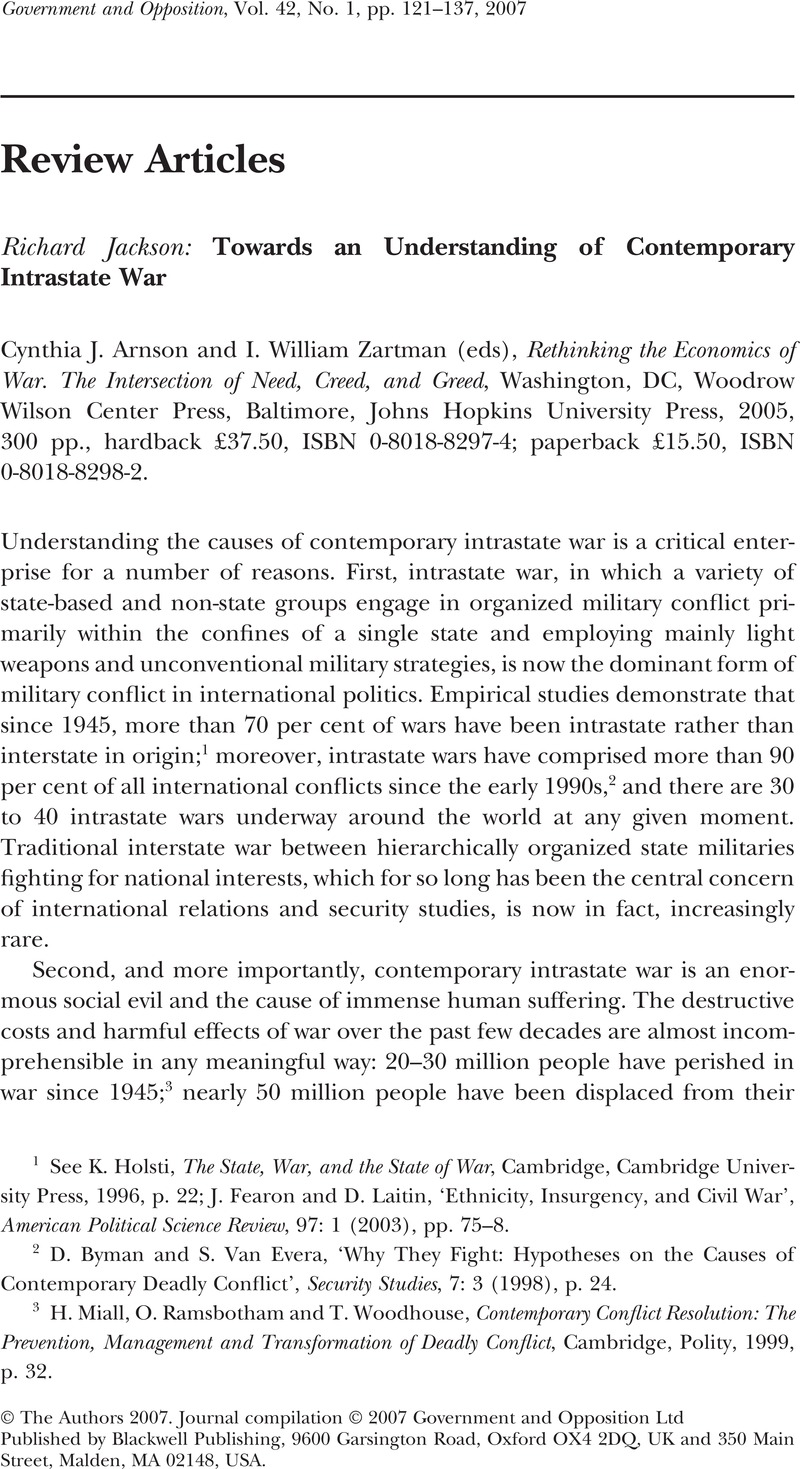Article contents
Towards an Understanding of Contemporary Intrastate War
Published online by Cambridge University Press: 28 March 2014
Abstract

- Type
- Review Articles
- Information
- Copyright
- Copyright © Government and Opposition Ltd 2007
References
1 See K. Holsti, The State, War, and the State of War, Cambridge, Cambridge University Press, 1996, p. 22; Fearon, J. and Laitin, D., ‘Ethnicity, Insurgency, and Civil War,’ American Political Science Review, 97: 1 (2003, pp. 75–8.CrossRefGoogle Scholar
2 Byman, D. and Van Evera, S., ‘Why They Fight: Hypotheses on the Causes of Contemporary Deadly Conflict,’ Security Studies, 7: 3 (1998), p. 24.CrossRefGoogle Scholar
3 H. Miall, O. Ramsbotham and T. Woodhouse, Contemporary Conflict Resolution: The Prevention, Management and Transformation of Deadly Conflict, Cambridge, Polity, 1999, p. 32.Google Scholar
4 Holsti, The State, War, p. 40.Google Scholar
5 It is estimated that in the former Yugoslavia alone, there may have been as many as 75,000 victims of war crimes by 1994, including 25,000 rapes, many in special rape detention camps. See F. Wilmer, The Social Construction of Man, the State, and War: Identity, Conflict, and Violence in the Former Yugoslavia, London, Routledge, 2002, p. 60.Google Scholar
6 M. Berdal and D. Malone (eds), Greed and Grievance. Economic Agendas in Civil Wars, Boulder, CO, Lynne Rienner, 2000; K. Ballentine and J. Sherman (eds), The Political Economy of Armed Conflict. Beyond Greed and Grievance, Boulder, CO, Lynne Rienner, 2003; M. Pugh and N. Cooper (eds), War Economies in a Regional Context: Challenges of Transformation, Boulder, CO, Lynne Rienner, 2004.Google Scholar
7 P. Collier and A. Hoeffler, Greed and Grievance in Civil War, Policy Research Working Paper 2355, Washington, World Bank, 2000, pp. 26–7.Google Scholar
8 P. Collier, ‘Doing Well Out of War’, in Berdal and Malone, Greed and Grievance, p. 110.Google Scholar
9 Collier has suggested more recently that in terms of direct causality, greed ‘does not appear to be the powerful force behind rebellion that economic theorists have assumed’, Breaking the Conflict Trap: Civil War and Development Policy, World Bank Report, Washington, World Bank, 2003, p. 64.Google Scholar
10 M. Kaldor, New and Old Wars: Organized Violence in a Global Era, Cambridge, Polity, 1999.Google Scholar
11 See M. Duffield, Global Governance and the New Wars: The Merging of Development and Security, London, Zed Books, 2001.Google Scholar
12 See Jackson, R., ‘Violent Internal Conflict and the African State,’ Journal of Contemporary African Studies, 20: 1 (2002, pp. 29–52.CrossRefGoogle Scholar
13 M. Ayoob, ‘State Making, State Breaking, and State Failure’, in C. Crocker, F. Hampson and P. Aall, (eds), Managing Global Chaos: Sources of and Responses to International Conflict, Washington, DC, United States Institute of Peace Press, 1996.Google Scholar
14 I. W. Zartman, ‘Introduction: Posing the Problem of State Collapse’, in I. W. Zartman (ed.), Collapsed States: The Disintegration and Restoration of Legitimate Authority, Boulder, CO, Lynne Rienner, 1995.Google Scholar
15 J. Migdal, Strong Societies and Weak States: State–Society Relations and State Capabilities in the Third World, Princeton, NJ, Princeton University Press, 1988, pp. 227–9.Google Scholar
16 Azam, J., ‘The Redistributive State and Conflicts in Africa,’ Journal of Peace Research, 38: 4 (2001, pp. 429–44.CrossRefGoogle Scholar
17 See S. Kaufman, Modern Hatreds: The Symbolic Politics of Ethnic War, London, Cornell University Press, 2001; R. Lemarchand, Burundi: Ethnocide as Discourse and Practice, Washington, DC, Woodrow Wilson Center Press, 1994; F. Wilmer, The Social Construction of Man, the State, and War: Identity, Conflict, and Violence in the Former Yugoslavia, New York, Routledge, 2002.Google Scholar
18 R. Jackson, ‘The Social Construction of Internal War’ in R. Jackson (ed.), (Re)Constructing Cultures of Violence and Peace, New York, Rodopi, 2004. See also V. Jabri, Discourses on Violence: Conflict Analysis Reconsidered, Manchester, Manchester University Press, 1996.Google Scholar
- 2
- Cited by


